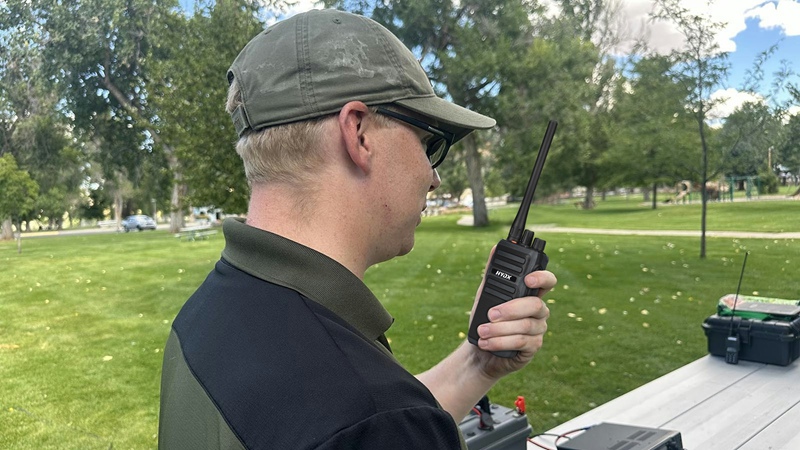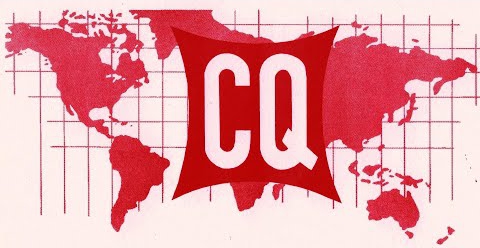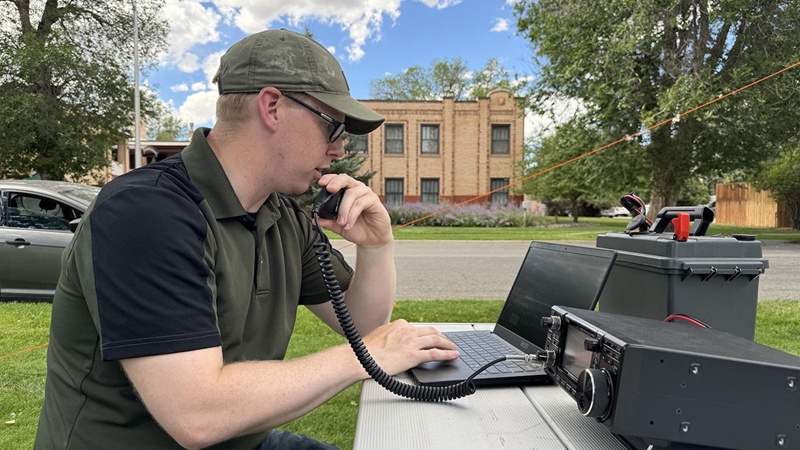Surrounded by the green grass tranquility of Hot Springs State Park, a temporary ham radio antenna reached into the sky.
Here, amateur two way radio operator Casey Freund sat in the shade at a park picnic table along with his ham radio, laptop and portable DMR ameteur radio. He was ready to communicate on a device that had its start more than 100 years ago, and was essential to civilization before Wi-Fi and smartphones.
“There are calculations you can do to find antennas that work on multiple frequencies, but they're a little harder to build yourself,” Freund said. “This is a super easy antenna that took me about 15 minutes to build last year and I measured off the piece of wire that we're using today to be harmonic to the radio frequency that we're going to be on.”
Plugging his radio and laptop into his battery pack, a homemade system housed in a plastic ammo box, Freund was now ready to “key up” which means “to transmit” in ham radio jargon.

Carefully fine tuning his radio, Freund checked various walkie talkie frequencies for a clear channel catching bits of conversations. He paused on one conversation which sounded like a long-distance tailgate party as the men discussed eating crackers and drinking wine from the back of their pickup truck.
“There are a lot of random conversations going on in nets,” Freund explained using another ham radio term. For the uninitiated, “net” is an on-air gathering.
Freund doesn’t have the capability to join the 80-meter Cowboy Net since his antenna is a smaller 20-meter set-up. However, his favorite parts of the hobby are not the conversation. He prefers to ‘CQ’ which means that the radio operator is calling out for anyone to respond for a quick contact. Freund would then log their signal strength, location and call sign into his laptop.
Freund adjusted the dial on his radio transceiver, still searching for a clear frequency. He set up his antenna and gear purposely in the Hot Springs State Park in Thermopolis so he could participate in his favorite program called “Parks On The Air”.
“You are trying to get as many people as you can in a short period of a time,” Freund said. He continued to move his dial in search of a clear frequency. Static, clicks, beeps and voices reminiscent of Star Wars characters came over the airwaves.
“It's like a contest, a little game,” he said.
The conversations are quick. Every state or national park has an identifying park number assigned to it and for Hot Springs State Park the number is 3299. This system allowed the operators to exchange their call signs, signal strength, location and radio call sign before moving on to the next person.
“We call it a handshake,” Freund said. “I hear you. You hear me. Here's your signal report. Here's my signal report. How well you're hearing everything. And then the park numbers. It’s a lot of trying to make as many contacts as quick as you can.”
Freund paused on a static filled frequency and called out, “CQ, CQ is this frequency in use?”
He asked the question three times. Confident that he had found a clear frequency, Freund keyed in and almost immediately made contact.
“This is Kilo Charlie 7 Echo at 3299,” Freund rattled off his personal call sign, KC7E, and the park number.
“You are about a 5.9 in Portland,” came the response which was the radio signal strength and location.
“QSL. I copy the Portland,” Freund said, which translates to “I acknowledge your signal report. I heard you say that you are in Portland.”
“I appreciate it, 73,” the Portland operator said, signing off with the “73” which is ham radio speak for “Cheers and Best Wishes.”
“73,” Freund said, moving to the next operator and handshake.

The contacts were rapid and within eleven minutes, Freund had made 16 contacts in 10 different states such as Texas, Oregon, Arizona and Missouri and two Canadian Provinces.
“I'll log my contacts on the computer and when I talk to people, you'll hear us saying a weird set of numbers and letters which is our call sign,” Freund said. “For example, ‘Whiskey Seven Romeo Tango Alpha’ was his call sign for W7RTA.”


